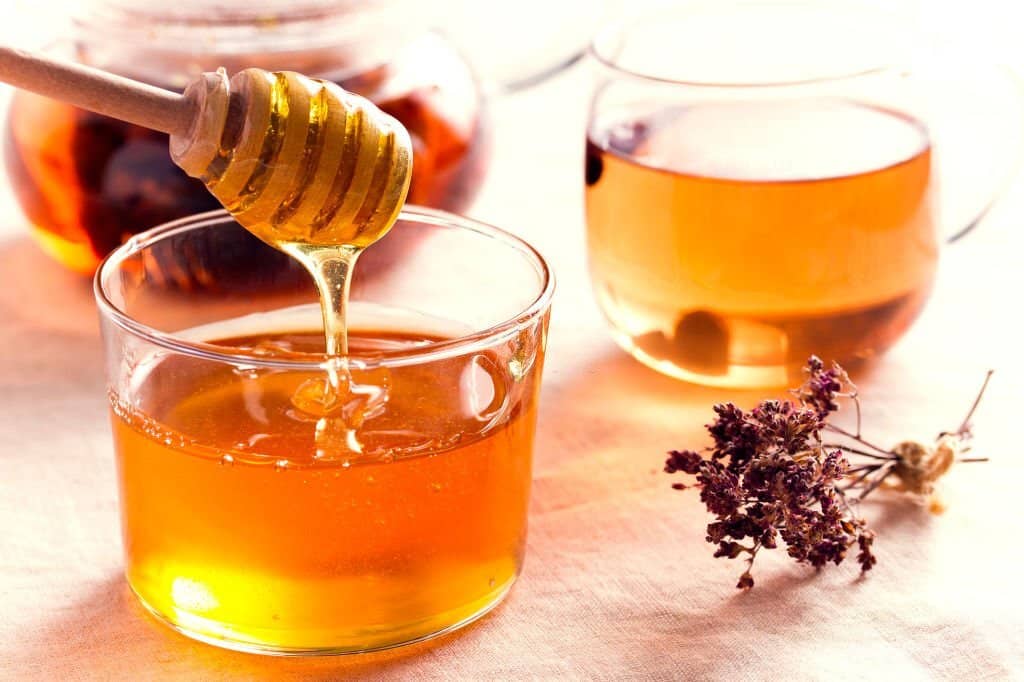Yes, you Can Freeze honey, but it’s not recommended due to its natural properties. Honey has little water and a lot of sugar, which can make it crystallize and get thicker when it freezes.
Even though freezing honey won’t make it go bad, it can change how it feels and looks.
To get honey back to its original state after it has hardened, slowly warm the jar in warm water, but don’t let it get too hot.
If you need to store honey, keep it at room temperature in a cool, dry place. This way, it keeps its quality and natural traits without having to be frozen.

What is Honey?
Honey is a natural sweetener that is produced by bees.
It is made from the nectar of flowers and contains a mixture of sugars, enzymes, and other nutrients.
Honey has been used for thousands of years as a food and a medicine, and it is still popular today for its taste and health benefits.
How To Crystallize Honey?
Crystallizing honey is a natural process that can be encouraged if you prefer honey in its crystallized form. Raw honey is more likely to crystallize than treated honey.
Maintain a cool storage temperature between 50°F and 70°F (10°C to 21°C) and leave the honey jar open to dissipate moisture.
Crystallization takes weeks to months, so be patient. Stir honey carefully for fewer crystals and faster processing. Reseal the jar when it’s crystallized to get spreadable, creamy honey.
How To Decrystallize Honey?
Decrystallizing honey is a straightforward process to restore it to its liquid state. Start by making a warm water bath at 100°F to 110°F (38°C to 43°C).
Submerge the crystallized honey jar in warm water without water entering. Wait 30–60 minutes for the mild heat to dissolve the honey crystals.
Remove the container, gently mix the honey to recombine the crystals, and it’s ready to use liquid. Avoid boiling water and microwaving honey to retain flavor and nutrition.
What Happens When You Freeze Honey?
When you freeze honey, it doesn’t actually freeze solid like water due to its low water content and high sugar concentration. Instead, freezing honey has two main impacts.
Firstly, It accelerates crystallization, making honey thicker and grainier. This is normal and doesn’t suggest deterioration; simply warming honey will liquidize it.
Second, frozen honey may expand, putting strain on the container and perhaps breaking it. Avoid this by freezing honey in freezer-safe containers with room for expansion or transferring it to smaller containers. Honey is still safe to eat and has the same nutritional benefits and flavor.
Why Should You Freeze Honey?
Honey is naturally spoil-resistant, thus freezing it is rare. Honey’s low water and high sugar content make microbes struggle. Thus, honey has a long shelf life and doesn’t need freezing.
However, some people freeze honey to prevent crystallization, especially if they have an excess or want to preserve speciality honeys.
Keeping honey cold, dry, and at room temperature is usually enough. Freezing is not necessary for daily use.
How Long Can You Freeze Honey?

Honey can be frozen indefinitely without spoiling, but freezing isn’t recommended due to potential changes in texture and crystallization.
If necessary, freeze honey for up to 6 to 12 months for better quality. You can thaw frozen honey by slowly warming the container in warm water, but honey is best kept at room temperature to preserve its natural properties.
Does Freezing Honey Destroy Nutrients?
Freezing honey does not destroy its nutrients. Honey is low in water and abundant in sugars, mostly glucose and fructose. Honey has a long shelf life since most bacteria cannot live in it.
Freezing honey prevents deterioration by preventing microbial development. Honey’s purity and nutritional value are preserved by freezing.
How to Freeze Honey

Freezing honey is a simple process. Here’s what you need to do:
- Choose the Right Container: To freeze honey, choose a clean, sealed container or jar that can go in the freezer. Make sure the jar is made for freezing to keep the honey’s quality and prevent freezer burn.
- Leave Room for Expansion: When you pour the honey into the container, leave a little room at the top so it can grow as it freezes. Honey can get bigger when it gets cold, so leaving space helps keep the jar from breaking.
- Seal Tightly: Make sure the lid is on tight so that air doesn’t get in and change the taste and flavor of the honey.
- Label and Date: Use a pen to write the date that the food should be frozen on the container. This helps you keep track of how long it’s been in the freezer.
- Quickly freeze: Put the sealed container in the freezer and make sure it stays at or below 0°F (-18°C) at all times.
- Thawing: When you’re ready to use the frozen honey, put it in the fridge so it can slowly thaw. Depending on how much, this could take a few hours or even the whole night.
- Use as usual. Thawed honey can be used in recipes, to sweeten drinks, or as a topping just like fresh honey. It keeps its original taste and nutritional value.
Final Thoughts
Freezing honey long-term is safe and effective. Use a freezer-safe jar and slowly thaw before using.
Although frozen honey tastes and feels different from fresh honey, it is safe to eat and can be used in many recipes.
Learn More: Why Dessert is Important After Meal

